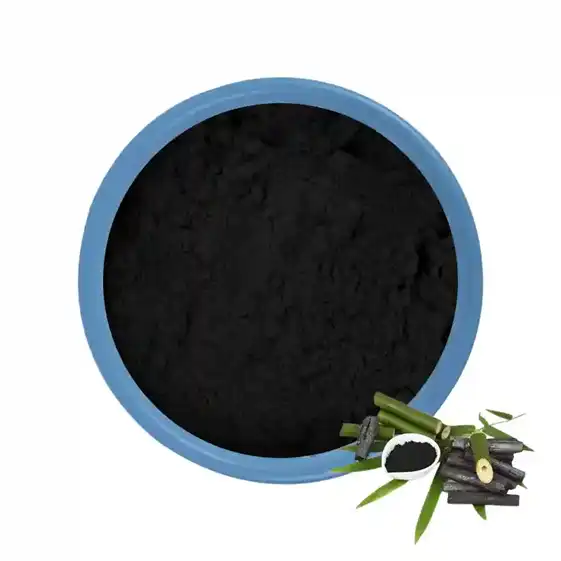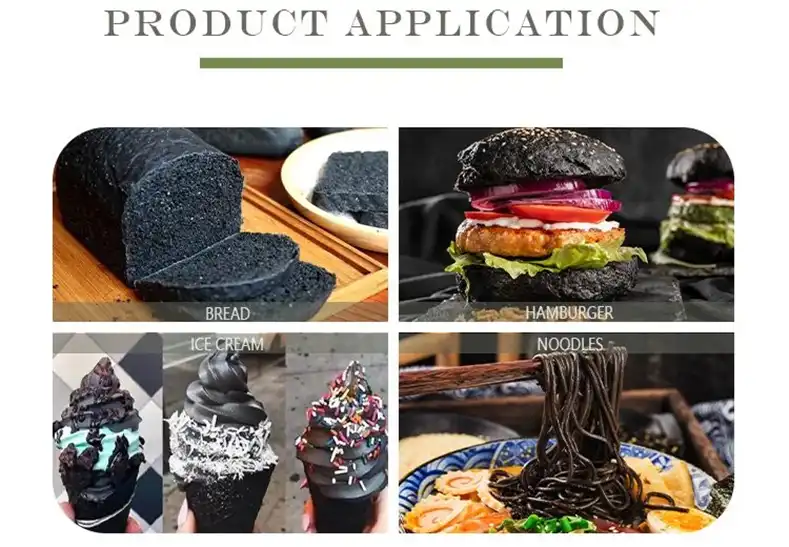Carbon Black Powder – The Natural Food Coloring
The Versatile Power of Carbon Black Powder: Applications, Benefits, and Industry Uses
Carbon black powder, though often overlooked, plays a crucial role across various industries due to its unique properties. Derived from the partial combustion of hydrocarbons, carbon black powder is a fine, black particulate substance that boasts exceptional durability, conductivity, and UV protection. Whether in automotive, electronics, plastics, or coatings, this powerful compound is indispensable in enhancing product performance and longevity.
What is Carbon Black Powder?
Carbon black is a highly refined form of elemental carbon produced by the controlled combustion of natural gas or heavy petroleum. The fine particles are aggregated into powder form, with specific properties like particle size, structure, and surface activity, tailored to meet diverse industry requirements. Its unique characteristics include high resistance to wear, chemical stability, and ability to absorb UV light, making it a valuable ingredient in multiple applications.

Key Applications of Carbon Black Powder
Automotive Industry
Tire Manufacturing: Carbon black is widely used in tire production due to its ability to enhance strength, wear resistance, and longevity. By reinforcing rubber, it provides additional durability, making tires more resilient to harsh road conditions and reducing wear.
Body Coatings and Interiors: Carbon black’s protective qualities add UV resistance to automotive interiors and coatings, helping maintain color and texture, even after prolonged sun exposure.
Plastics and Polymers
Conductive Polymers: Carbon black is often used in electronic devices as a conductive filler. Adding carbon black to polymers and plastics not only increases conductivity but also adds stability, enabling the production of antistatic materials for sensitive electronic environments.
Plastic Coloration and UV Stabilization: Carbon black is a superior choice for pigmentation and UV protection in plastics, especially outdoor materials. Its color stability and durability ensure longevity in products, even with constant exposure to sunlight and environmental factors.
Coatings and Inks
Pigment in Paints and Coatings: Carbon black’s intense black pigmentation is widely used in paints, inks, and coatings, providing deep color and excellent opacity. Its durability adds longevity, ensuring that coated surfaces retain their color over time.
Inkjet and Toner Manufacturing: The superior blackness and fine particle size make it ideal for creating high-definition prints. Carbon black enhances the sharpness and durability of printed material, making it a popular choice for high-quality inkjet cartridges and toners.
Battery Manufacturing
Electrode Material in Batteries: In the energy sector, carbon black is used as an additive in battery electrodes, improving conductivity and performance. This application is especially valuable in lithium-ion batteries, where it enhances energy density and longevity.

Benefits of Carbon Black Powder
Enhanced Durability and Resilience
Carbon black increases the mechanical strength and wear resistance of materials, helping them withstand harsh environmental conditions, temperature changes, and frequent use without degradation. This characteristic makes it especially valuable in automotive and heavy-duty applications.
UV Protection and Color Retention
Carbon black’s natural UV absorption qualities protect materials from sun-induced degradation. This feature helps maintain color and integrity, especially in outdoor products and structures exposed to direct sunlight.
Thermal Conductivity and Insulation
In applications where thermal regulation is critical, such as in battery manufacturing, carbon black’s ability to conduct and manage heat helps enhance performance. Its fine structure enables efficient thermal transfer or insulation, depending on the application requirements.
Environmental Stability
Carbon black powder is chemically stable and does not easily react with other substances. This stability ensures that products maintain their integrity over time, even under adverse conditions, contributing to long product life cycles.

Applications of Vegetable Carbon Black in Food
One of the reasons for the growing popularity of vegetable carbon black is its versatility. Its deep black color can elevate the visual appeal of a wide range of foods. Here are some common applications:
1. Confectionery:
The black hue of vegetable carbon powder makes it a go-to colorant for candies, chocolates, and licorice. Its ability to provide a rich black color without impacting taste makes it ideal for sweets that rely on their visual appearance to attract consumers.
2. Baked Goods:
From black macarons to striking black burger buns, vegetable carbon black is often used in bakery products to create bold, unique items. It not only adds an element of surprise but also distinguishes products from standard offerings.
3. Beverages:
The trend of activated charcoal drinks has paved the way for carbon black powder to enter the beverage industry. Smoothies, detox juices, and even cocktails benefit from the intense black color, making drinks visually captivating.
4. Snack Foods:
Vegetable carbon black is also used in chips, crackers, and savory snacks to create an eye-catching contrast with lighter ingredients. Black snacks stand out on store shelves and appeal to consumers seeking novelty in their food choices.
5. Sauces and Dressings:
Carbon black powder can be used in dark sauces and dips to enhance their visual appeal. Whether it's a black garlic sauce or a smoky chipotle dip, the addition of vegetable carbon black creates an aesthetically striking presentation.
6. Ice Cream and Desserts:
Ice cream parlors are embracing the boldness of black ice cream, and vegetable carbon black powder is one of the key colorants making this trend possible. From black sesame ice cream to dark chocolate sorbet, this colorant brings an extra layer of visual intrigue to frozen desserts.

The Benefits of Vegetable Carbon Black
Using vegetable carbon black as a food coloring offers several advantages:
Clean Label: As a natural, plant-based ingredient, it aligns with the clean-label movement. Consumers want transparency, and vegetable carbon black is a simple, recognizable ingredient.
Sustainable and Eco-Friendly: Derived from renewable plant materials, it contributes to eco-friendly production processes. Its biodegradability also means it leaves less environmental impact compared to synthetic alternatives.
Vegan and Allergen-Free: Vegetable carbon black is free from animal products and common allergens, making it suitable for a wide range of diets, including vegan and gluten-free.
Non-Toxic and Safe: Unlike some synthetic black dyes, which can pose health risks, vegetable carbon black is considered safe for human consumption. Its use, however, is regulated and approved in many regions.
Visual Appeal: From artisan bakeries to trendy juice bars, black-colored foods have gained popularity for their bold, dramatic appearance. Carbon black offers food producers a way to stand out and make a memorable impression on consumers.
Regulatory Considerations
While vegetable carbon black powder is widely accepted as a food additive, its usage is regulated and varies by region. For instance, in the European Union, it is approved as E153, but it may be subject to restrictions in other countries. Manufacturers should always check with local food safety authorities to ensure compliance with regulations before using it in their products.
Where to Buy Carbon Black Powder?
You can purchase Carbon Black Powder available with free sample at yanggebiotech.com. The company is an industry-leading manufacturer and distributor for pure dietary supplements. YANGGE BIOTECH INGREDIENTS is not just a consumer brand. It also supplies pure ingredients to other brands that distribute food and other supplement products. Contact Us to place an order today.
Wrapping up, As the food industry continues to shift toward more natural, sustainable ingredients, Carbon Black Powder is emerging as a powerful alternative to synthetic black dyes. Its ability to create rich, dark colors in foods without compromising safety or sustainability makes it a valuable tool for modern food production.
Why Choose Yangge Biotech for Your Carbon Black Powder Needs
Introduction
In industries that rely on high-performance materials, selecting the right carbon black powder supplier is crucial. Yangge Biotech has set itself apart by offering premium quality carbon black powder designed to meet the highest standards across various industries. Here’s why Yangge Biotech stands out as the best source for carbon black powder.
1. Unmatched Product Quality
Yangge Biotech’s carbon black powder is crafted using advanced manufacturing processes, ensuring a consistent, finely milled powder that delivers exceptional performance. Each batch undergoes strict quality control measures to ensure purity, consistency, and optimal particle size, resulting in a product you can trust.
2. Versatile Range of Applications
With a product portfolio tailored to meet diverse industry needs, Yangge Biotech supplies carbon black powder that’s perfect for automotive, plastics, coatings, battery, and electronics applications. Each product is engineered for its intended application, whether it’s to enhance durability, improve UV stability, or increase electrical conductivity.
3. Innovative Production Techniques
Yangge Biotech is committed to sustainability and efficiency in production. By employing eco-friendly processes, Yangge minimizes environmental impact while maximizing product quality. This focus on innovation means that clients receive high-performance materials produced with minimal environmental footprint.
4. Consistent Supply and Reliable Delivery
Supply consistency is crucial for industries that rely on carbon black powder. Yangge Biotech maintains high inventory levels and a streamlined logistics network to ensure that orders are delivered on time, every time. This reliability gives customers peace of mind, knowing they can count on Yangge Biotech to meet their supply needs without delay.
5. Technical Expertise and Support
Yangge Biotech’s team of experts is available to provide technical support and advice, ensuring that customers receive the best product for their specific application. From helping choose the right grade to offering insights into product usage, Yangge’s technical team is there to help clients achieve optimal results.
6. Commitment to Sustainable Practices
In addition to producing high-quality materials, Yangge Biotech is dedicated to environmental sustainability. Through responsible manufacturing practices and a focus on reducing waste and emissions, Yangge demonstrates a commitment to protecting the environment, making it an ideal partner for companies prioritizing sustainability.
7. Competitive Pricing
Quality often comes at a premium, but Yangge Biotech’s efficient production processes allow it to offer competitive pricing without sacrificing product integrity. With Yangge, customers receive exceptional value for a superior product that meets all performance expectations.
8. Global Reach and Trusted Reputation
Yangge Biotech has built a reputation for excellence on a global scale, supplying carbon black powder to customers worldwide. With a commitment to high standards and client satisfaction, Yangge Biotech has become a trusted name in the industry.
References:
https://blog.praterindustries.com/what-is-carbon-black-and-how-is-it-made
Applications (rCB) - Black Bear. (n.d.-b). Retrieved March 5, 2024, from https://blackbearcarbon.com/products-2-2/
Carbon Black Properties and Applications - Nanografi Nano Technology. (n.d.). Retrieved March 5, 2024, from https://nanografi.com/blog/carbon-black-properties-and-applications/
C-NERGY Super C65 Conductive Carbon Black - Nanografi Nano Technology. (n.d.). Retrieved March 5, 2024, from https://nanografi.com/blog/cnergy-super-c65-conductive-carbon-black/
González-González, R. B., González, L. T., Iglesias-González, S., González-González, E., Martinez-Chapa, S. O., Madou, M., Alvarez, M. M., & Mendoza, A. (2020). Characterization of Chemically Activated Pyrolytic Carbon Black Derived from Waste Tires as a Candidate for Nanomaterial Precursor. Nanomaterials 2020, Vol. 10, Page 2213, 10(11), 2213. https://doi.org/10.3390/NANO10112213
Methodology followed for the recovery of pyrolytic carbon black from... | Download Scientific Diagram. (n.d.). Retrieved March 5, 2024, from https://www.researchgate.net/figure/Methodology-followed-for-the-recovery-of-pyrolytic-carbon-black-from-waste-tires-and-the_fig1_345438268
Nanotechnology to Better the Diesel Engine Performance - Nanografi Nano Technology. (n.d.). Retrieved March 5, 2024, from https://nanografi.com/blog/nanotechnology-to-better-the-diesel-engine-performance/
Three Main Properties of Carbon Black. (n.d.). Retrieved March 5, 2024, from http://www.carbonblack.jp/en/cb/tokusei.htm
Send Inquiry
Related Industry Knowledge
- Mung Bean Protein Peptide: A Natural Powerhouse of Health Benefits
- Lactoferrin: What It Is and Why It Matters for Your Health
- Psylliumus Hk: The Superfood for Optimal Health
- What is Glutathione and Why Do We Need it?
- Turmeric with Black Pepper: Ginger Benefits
- Omega 3 epa vs dha
- Exploring the Power of Cocoa Shell Extract: A Natural Wonder with Unique Benefits
- hemp protein benefits for skin
- How can you benefits from almond protein powder?
- Explore the Nutritional Value of Butterfly Pea Powder


